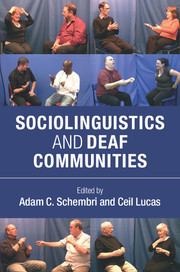Book contents
- Frontmatter
- Contents
- List of Figures
- List of Tables
- Notes on Contributors
- 1 Introduction
- 2 Sign languages in the world
- 3 Sign languages in contact
- 4 Variation and change in sign languages
- 5 Discourse analysis and sign languages
- 6 Language policy and planning in Deaf communities
- 7 Language attitudes in Deaf communities
- Index
- References
4 - Variation and change in sign languages
Published online by Cambridge University Press: 05 February 2015
- Frontmatter
- Contents
- List of Figures
- List of Tables
- Notes on Contributors
- 1 Introduction
- 2 Sign languages in the world
- 3 Sign languages in contact
- 4 Variation and change in sign languages
- 5 Discourse analysis and sign languages
- 6 Language policy and planning in Deaf communities
- 7 Language attitudes in Deaf communities
- Index
- References
Summary
All human languages vary in both time and space as well as according to the linguistic environment in which a particular form is used. For example, the ASL sign DEAF has three main forms. It can be produced with a movement from ear to chin (the citation or dictionary form), from chin to ear or by contacting the check once (both non-citation forms). Even though the form of DEAF varies from signer to signer, and even within the signing of the same signer, the variation we observe is not random. Rather, signers’ choices among the three forms of DEAF are systematically constrained by a range of linguistic and social influences, or factors. For example, compared to signers in other parts of the United States, signers in Boston, Massachusetts use the citation form of DEAF more often. In contrast, signers in Kansas, Missouri, and Virginia tend to prefer non-citation forms. Indeed, a study of variation in the sign DEAF showed that signers in these states used non-citation forms of DEAF 85 percent of the time, more than twice the rate of signers in Boston (Bayley, Lucas, and Rose 2000: 92).
The region of the country where a signer lives is not the only influence on the choice of a form of DEAF. For example, although ASL signers in Boston generally used more citation forms of DEAF than signers in other areas of the United States, Boston signers aged 55 and older are far less likely to choose a non-citation form of DEAF than are younger signers. Bayley et al. (2000) reported that Boston signers aged 55 and older used the citation form of DEAF 76 percent of the time. In contrast, signers between the ages of 26 and 55 used the citation form 54 percent of the time, and signers between the ages of 14 and 26 used the citation form only 46 percent of the time. In addition, variation can be affected by linguistic factors. To continue with the example of DEAF, Lucas (1995) and Bayley et al. (2000) found that signers were very likely to use a non-citation form of DEAF when it was part of a compound, as in DEAF^CULTURE or DEAF^WORLD. However, when DEAF was a predicate adjective, as in PRO.1 DEAF (‘I am deaf’), signers were more likely to choose the citation form.
- Type
- Chapter
- Information
- Sociolinguistics and Deaf Communities , pp. 61 - 94Publisher: Cambridge University PressPrint publication year: 2015
References
- 3
- Cited by



